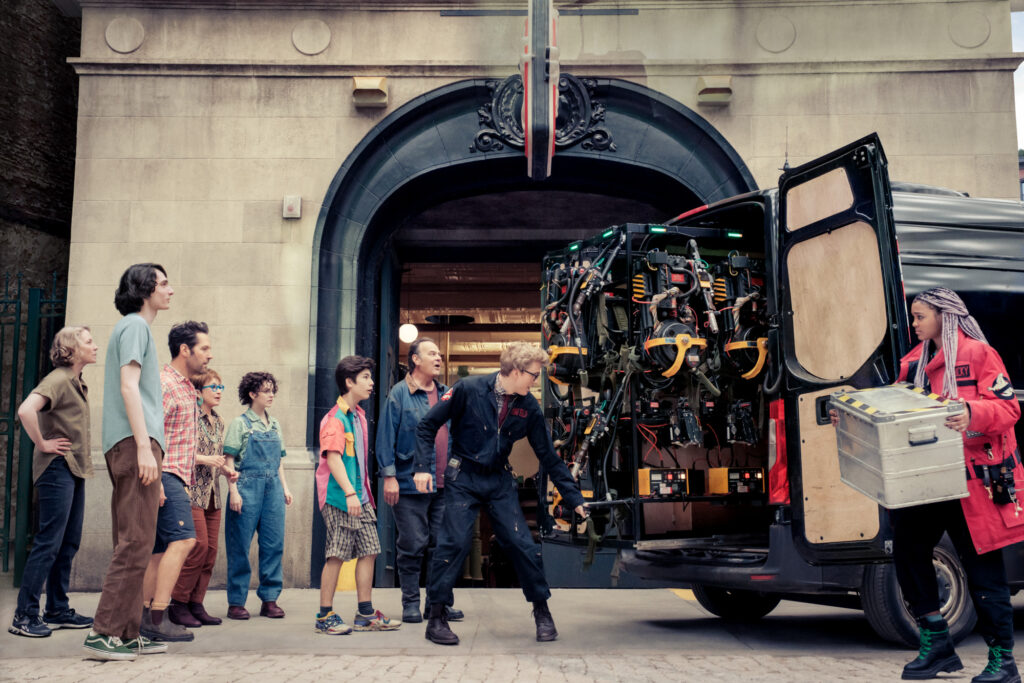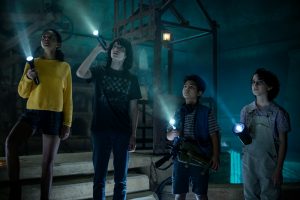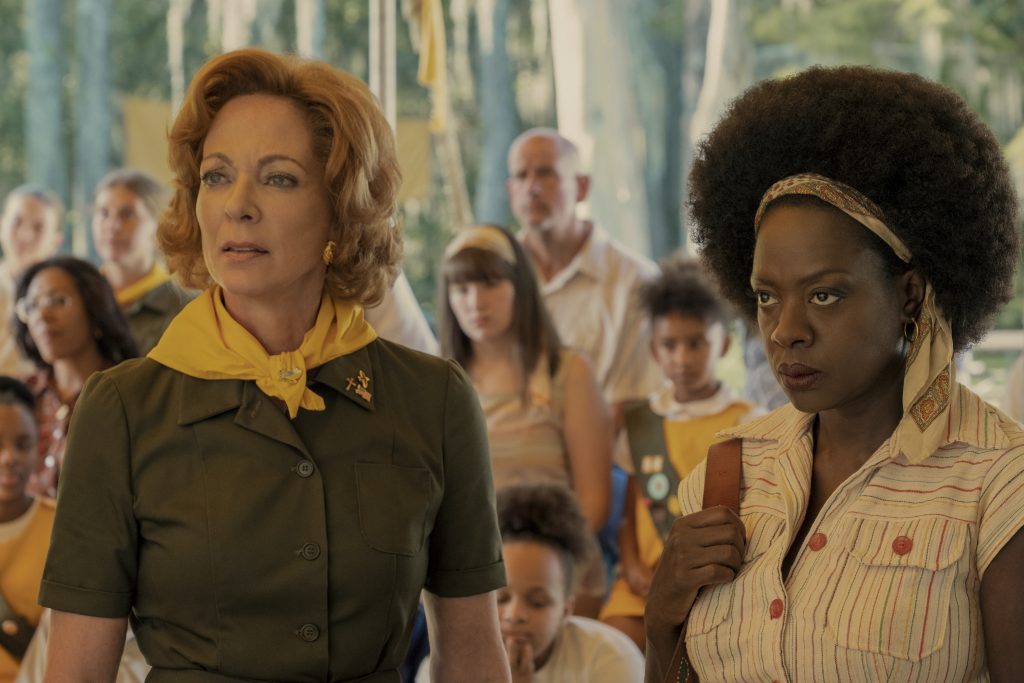March 20, 2024
by Carla Hay

Directed by Gil Kenan
Culture Representation: Taking place in New York City, the comedy/horror film “Ghostbusters: Frozen Empire” features a predominantly white cast of characters (with some African Americans and Asians) representing the working-class and middle-class.
Culture Clash: The Ghostbusters (a ghost-fighting team) battle against an ancient demon with freezing powers, as the mayor of New York City wants to shut down the Ghostbusters for causing destruction and violating various laws.
Culture Audience: “Ghostbusters” will appeal primarily to people who are fans of the “Ghostbusters” franchise and the movie’s headlines, but the movie doesn’t have a good-enough story to justify its weak new characters and how the movie sidelines too many of the franchise’s likable familiar characters.

Unfocused and overstuffed, “Ghostbusters: Frozen Empire” is proof that fan-service nostalgia and too many underdeveloped characters cannot make up for a shoddy story. Bill Murray has the worst jokes in the movie. The fact that the Murray’s Peter Venkman character—who is supposed to be the funniest person in the “Ghostbusters” franchise—is stuck with uninspired, unfunny and embarrassing lines of dialogue in “Ghostbusters: Frozen Empire” tells you all you need to know about what a terrible, wasted opportunity this mess of a movie is.
“Ghostbusters: Frozen Empire” is the follow-up to 2021’s “Ghostbusters: Afterlife,” a somewhat flawed but still fun reboot of the “Ghostbusters” movie series. Both movies were co-written by Jason Reitman and Gil Kenan. Reitman directed “Ghostbusters: Afterlife.” Kenan directed “Ghostbusters: Frozen Empire.”
The “Ghostbusters” series began with 1984’s “Ghostbusters” (still the best movie in the series) and continued with 1989’s “Ghostbusters 2,” with both movies directed by Ivan Reitman (father of Jason Reitman) and written by Dan Aykroyd and Harold Ramis, two of the original “Ghostbusters” co-stars. There is also director Paul Feig’s divisive 2016 “Ghostbusters” reboot, led by an all-female Ghostbusters team, starring Kristen Wiig, Melissa McCarthy, Leslie Jones and Kate McKinnon.
The screenwriting is the weakest link in “Ghostbusters: Frozen Empire.” New characters are introduced but they are mostly hollow and have shallow personalities. The “sidekick” teenage characters who were introduced in “Ghostbusters: Afterlife”—Podcast (played by Logan Kim) and Lucky Domingo (played by Celeste O’Connor)—have their roles and screen time reduced in “Ghostbusters: Frozen Empire,” thereby robbing audiences of getting to know Podcast and Lucky better. And the franchise’s original characters from the first two “Ghostbusters” movies are given flat and unimaginative things to do in “Ghostbusters: Frozen Empire.”
“Ghostbusters: Frozen Empire” begins by showing that the core four Ghostbusters, who became a team in “Ghostbusters: Afterlife,” have relocated from Oklahoma, and are now living at the firehouse that is the Ghostbusters headquarters in New York City. The core four are seismologist and former science teacher Gary Grooberson (played by Paul Rudd); Callie Spengler (played by Carrie Coon), a divorcée who began dating Gary in “Ghostbusters: Afterlife”; Trevor Spengler (played by Finn Wolfhard), Callie’s impulsive 18-year-old son; and Phoebe Spengler (played by Mckenna Grace), Callie’s intelligent 15-year-old daughter.
Callie is the daughter of Egon Spengler (played by the late Ramis), who was a member of the original Ghostbusters team. Ramis died in 2014, at the age of 69, from complications from autoimmune inflammatory vasculitis. Phoebe is supposed to be a lot like a young, female version of Egon. She is a self-admitted “science nerd,” who is also a quick problem solver and the person most likely in the group to come up with invention ideas.
Podcast (whose real name is never revealed) and Lucky, who met Trevor and Phoebe when they all went to the same school together in Oklahoma, have also relocated from Oklahoma to New York City. “Ghostbusters: Frozen Empire” never explains why Lucky’s parents (who are never shown or talked about in the film) agreed to this move. Podcast is shown having a brief phone conversation with his parents, who think he is way at summer camp. Podcast and Lucky, who are supposed to still be under 18, are never shown in school in “Ghostbusters: Frozen Empire.” Podcast and Lucky are only in the movie to show up and give occasional help to the core four Ghostbusters.
An opening action scene “Ghostbusters: Frozen Empire” show Gary, Callie, Trevor and Phoebe chasing a sewer dragon ghost through the streets of New York City. This chase causes a lot of destruction and infuriates Walter Peck (played by William Atherton), the grouchy mayor of New York City. Mayor Peck despises the Ghostbusters and wants to shut down the entire Ghostbusters operation. In the meantime, he punishes them for violating child labor laws, because Phoebe is underage. Gary and Callie are forced to sideline Phoebe from Ghostbuster work. Phoebe is predictably unhappy about this decision, but she finds a way to rebel against her Ghostbusters ban anyway.
One night, Phoebe is playing chess by herself in Washington Square Park (why is she playing chess alone?), when she meets a ghost named Melody (played by Emily Alyn Lind), who died at the age of 16 in a tenement fire. Melody (whose ghostly body can light up in flames because of her fiery death) begins playing chess with Phoebe, who is never afraid of Melody and ends up becoming friendly with Melody. “Ghostbusters: Frozen Empire” drops major hints that Phoebe and Melody could have a romance—Phoebe, at least, is obviously romantically attracted to Melody—but the movie doesn’t go there, probably because Phoebe is only 15 years old. Phoebe’s sexuality could be addressed if this character continues in the “Ghostbusters” franchise as an adult.
Meanwhile, original Ghostbusters member Ray Stantz (played by Aykroyd) now owns a store called Ray’s Occult Books. On the side, Ray hosts a YouTube show produced by Podcast. One day, a man named Nadeem Razmaadi (played by Kumail Nanjiani) comes into to store to sell some family artifacts that used to be owned by his recently deceased grandmother. One of these artifacts is a dark gold brass orb, about the size of a grapefruit or bocce ball.
The movie has a long-winded way of revealing the obvious: The orb has trapped an evil demon named Garraka, which has the power to freeze things and people. Garraka wants to raise an army of the undead, according to librarian Hubert Wartzki (played by Patton Oswalt, in a quick cameo), who works at the New York City Library’s main branch. The branch’s famous lion statues Patience and Fortitude come to life n an action sequence that’s already revealed in the movie’s trailers. The way that Garraka looks is also revealed in the move’s trailers.
Winston Zeddemore (played by Ernie Hudson) is now a philanthropist who has opened the Paranormal Research Center. A somewhat snooty British parabiologist named Lars Pinfield (played by James Acaster) works for the Paranormal Research Center and is a completely useless and annyoing character. Original “Ghostbusters” character Janine Melnitz (played by Annie Potts) gets to wear a Ghostbusters team outfit but she isn’t gven much to do in her unnecessary cameo.
Grace and Nanjiani (who has talent to give charisma to even the most moronic lines of dialogue) give the best performances in this muddled movie. As for Murray, his Howard character is reduced to testing Nadeem to see if Nadeem is really human when Nadeem is suspected of possibly being a demon. He asks Nadeem a series of stupid questions, such as if he likes puppies or not. The movie makes half-hearted attempts at family sentimentality in showing how never-married bachelor Gary adjusts to being a father figure who is technically not a stepfather because he’s not married to Callie.
The adorable and mischievous Stay Puft marshmallows are barely in the in the movie. A mid-credits scene with the marshmallows is meant to be comedic but is very bland. The vibrant enthusiasm and engaging dialogue of “Ghostbusters: Afterlife” are missing in “Ghostbusters: Frozen Empire,” with many of the cast members giving “going through the motions” performances. “Ghostbusters: Frozen Empire” (which has mediocre visual effects) is a jumble of not-very-funny scenes that reach a very formulaic conclusion that you don’t need to be a ghostbusting psychic to easily predict.
Columbia Pictures will release “Ghostbusters: Frozen Empire” in U.S. cinemas on March 22, 2024.








